

Will Its Violent Death Impact Earth? The red giant, once so large it would reach out to Jupiter's orbit if placed in our own solar system, has shrunk by 15 percent over the past decade in a half, although it's just as bright as it's ever been.

"To see this change is very striking," said retired Berkeley physics professor Charles Townes, who won the 1964 Nobel Prize for inventing the laser. "We will be watching it carefully over the next few years to see if it will keep contracting or will go back up in size. " Betelgeuse, whose name derives from Arabic, is easily visible in the constellation Orion. Unsolved Mystery of Molecules Found in Andromeda & Triangulum Galaxies.
Figuring out exactly which molecules are leaving these clues, known as "diffuse interstellar bands" (DIBs), is a puzzle that initially seemed straightforward but has gone unsolved for nearly a hundred years.
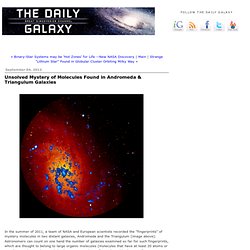
The answer is expected to help explain how stars, planets and life form, so settling the matter is as important to astronomers who specialize in chemistry and biology as determining the nature of dark matter is to the specialists in physics. First Ever Methane-Exhaling Microbes Discovered on Earth (Will Mars be Next?) By some estimates, a third of the Earth's organisms by mass live in our planet's rocks and sediments, yet their lives and ecology are almost a complete mystery.

This week, microbiologist James Holden at the University of Massachusetts Amherst and others report in Proceedings of the National Academy of Sciences the first detailed data about a group of methane-exhaling microbes that live deep in the cracks of hot undersea volcanoes. Planetary scientists have long been puzzling over what could be producing methane gas detected in Mars thin atmosphere. Methane molecules are easily blown apart by ultraviolet light from the Sun, so any methane around must have been released recently. Mars 'Curiosity' Science Lab Quickly Points to Water Flows at Gale Crater.
'Curiosity' Mission May Provide Proof (Weekend Feature) "We can now say that the planet was altered on a global scale by liquid water about four billion years ago.
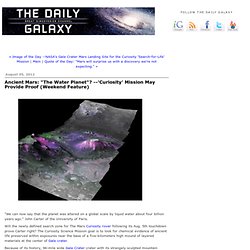
" John Carter of the University of Paris. Because of its history, 96-mile wide Gale Crater crater with its strangely sculpted mountain --three times higher than the Grand Canyon is deep--is the ideal place for Curiosity to conduct its mission of exploration into the Red Planet's past. Researchers plan to use Curiosity to study layers in the mountain that hold evidence about wet environments of early Mars. Minerals in northern Mars craters observed by two NASA orbiters suggested that a phase in Mars' early history with conditions favorable to life occurred globally, not just in the south. Southern and northern Mars differ in many ways, so the extent to which they shared ancient environments has been open to question. A Hot Zone for Habitable Planets? Looking like an image out of a video game, M 27, or NGC 6853 is a planetary nebula in the constellation Vulpecula, at a distance of about 1,360 light years.
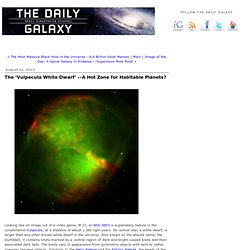
Its central star, a white dwarf, is larger than any other known white dwarf in the universe. Also known by the absurd name, the Dumbbell, it contains knots marked by a central region of dark and bright cusped knots and their associated dark tails. The knots vary in appearance from symmetric objects with tails to rather irregular tail-less objects. Similarly to the Helix Nebula and the Eskimo Nebula, the heads of the knots have bright cusps which are local. It could just be that the most productive to look for planets that can support life is around dim, dying stars called white dwarfs. The Weird Neuroscience of Immortality. Neuroscientist Kenneth Hayworth, 41, recently of Harvard and a veteran of NASA's Jet Propulsion Laboratory, believes that he can live forever, the Chronicle of Higher Education reports.
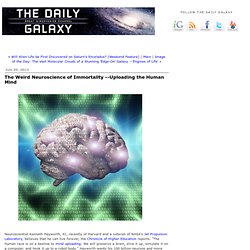
"The human race is on a beeline to mind uploading: We will preserve a brain, slice it up, simulate it on a computer, and hook it up to a robot body. " Hayworth wants his 100 billion neurons and more than 100 trillion synapses to be encased in a block of transparent, amber-colored resin—before he dies of natural causes. Why? Because Hayworth believes that he can live forever.
"If your body stops functioning, it starts to eat itself," Hayworth says, "so you have to shut down the enzymes that destroy the tissue. " The Vast Molecular Clouds of a Stunning 'Edge-On' Galaxy. Astronomers study these regions throughout the Milky Way and those easily seen in other galaxies to gauge the chemical makeup of cosmic environments and their influence on the formation of stars.

NGC 4700 appears to be an edge-on galaxy. It was discovered back in March 1786 by the British astronomer William Herschel who noted it as a "very faint nebula. " NGC 4700, along with many other relatively close galaxies, is found in the constellation of Virgo (The Virgin) and is classified as a barred spiral galaxy, similar in structure to the Milky Way. Astrobiologists Resurrect a 500-Million-Year-Old Gene. Using a process called paleo-experimental evolution, Georgia Tech researchers have resurrected a 500-million-year-old gene from bacteria and inserted it into modern-day Escherichia coli (E. coli) bacteria.

This bacterium has now been growing for more than 1,000 generations, giving the scientists a front row seat to observe evolution in action. “This is as close as we can get to rewinding and replaying the molecular tape of life,” said Kacar. “The ability to observe an ancient gene in a modern organism as it evolves within a modern cell allows us to see whether the evolutionary trajectory once taken will repeat itself or whether a life will adapt following a different path.” Using a process called paleo-experimental evolution, Georgia Tech researchers have resurrected a 500-million-year-old gene from bacteria and inserted it into modern-day Escherichia coli (E. coli) bacteria. When the researchers looked closer, they noticed that every EF-Tu gene did not accumulate mutations.
A Spectacular Star System. The discovery was made possible by exceptionally sharp ALMA images of a disc, or ring, of dust orbiting Fomalhaut, which lies about 25 light-years from Earth.
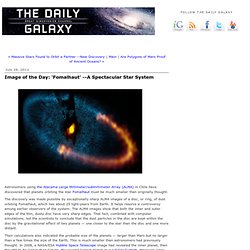
It helps resolve a controversy among earlier observers of the system. The ALMA images show that both the inner and outer edges of the thin, dusty disc have very sharp edges. Massive Stars Found to Orbit a Partner. "The orbit paths of the stars are very close together so that the region around these stars is turbulent and by far not as calm as previously thought," says Professor Norbert Langer from the University of Bonn.
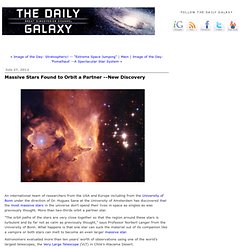
What happens is that one star can suck the material out of its companion like a vampire or both stars can melt to become an even larger massive star. Fermi Sleuths Find 5,000-Year-Old Pulsar Rotating 7 Times per Second. Pulsars are superlative cosmic beacons that rotate about their axes many times per second, emitting radio waves and gamma radiation into space. Using ingenious data analysis methods, researchers from the Max Planck Institutes for Gravitational Physics and for Radio Astronomy discovered a very special gamma-ray pulsar out of data from the Fermi Gamma-ray Space Telescope. The pulsar J1838-0537 is radio-quiet, very young, and, during the observation period, experienced the strongest rotation glitch ever observed for a gamma-ray-only pulsar.
Rare Glimpse of a Spectacular Protostar. Stephen Hawking Launches the Cosmos Supercomputer. Stephen Hawking has launched the most powerful shared-memory supercomputer in Europe, the COSMOS supercomputer, manufactured by SGI and the first system of its kind. Hawking says will open up new windows on the universe. The COSMOS supercomputer is part of the Science and Technology Facilities Council DiRAC High Performance Computing facility, a national service for UK cosmologists, astronomers and particle physicists, as well as non-academic users.
Hawking added, “I hope that we will soon find an ultimate theory which, in principle, would enable us to predict everything in the universe.” “However, participants at this workshop will be pleased to learn that this will not end our quest for a complete understanding,” he said. “Even if we do find the ultimate theory, we will still need supercomputers to describe how something as big and complex as the universe evolves, let alone why humans behave the way they do.” News of the Century? CERN to Announce its Findings on Higgs Boson Tomorrow. On July 4 at 9 a.m. in Geneva (3 a.m. in New York), officials at the Large Hadron Collider outside Geneva, Switzerland are expected to present new results on, and possibly the discovery of, the Higgs boson, the final missing piece of the Standard Model of physics, which explains the interactions between all known subatomic particles and forces, and is required to give all other particles their mass.
Its discovery would further validate the Standard Model as essentially correct, as it is the only elementary particle predicted by the Standard Model that has not yet been observed in particle physics experiments. If the results of the work at CERN can not show that the Higgs boson exists, much of our entire understanding of physics will need to be re-written. Tevatron at Fermilab in Illinois announced their latest data on July 2, which gives more strong evidence for the existence of the Higgs.
"We have developed sophisticated simulation and analysis programs to identify Higgs-like patterns. Black-Hole "Mine Field" Found in Distant Galaxy. Astronomers have found evidence of hundreds of black holes in a galaxy 250 million light years away. The discovery, made with a worldwide network of radio telescopes, gives scientists a new way to find out how black holes are created. These objects, known to astronomers as microblazars, were theoretically predicted over a decade ago. Proof of Ancient Water Systems. The 621 mile-by-1,240 mile (1,000 by 2,000-kilometer) region of Tyrrhena Terra (outlined by the white box in the inset) sits between two regions of low altitude in Mars' southern hemisphere, as shown in this global topography map.
Hydrated minerals were found in 175 locations associated with impact craters in Tyrrhena Terra. In a new study, ESA’s Mars Express and NASA’s Mars Reconnaissance Orbiter zoomed in on craters in on these ancient southern highlands to learn more about the history of water in this region. Startling New View of Most Galaxies. Strange Red Galaxies: "A Missing Link?"
Astronomers using the Spitzer Space Telescope discovered four extremely red galaxies that lie almost 13 billion light-years from Earth that appear to be physically associated and may be interacting. One galaxy shows signs of an active galactic nucleus, shown here as twin jets streaming out from a central black hole. A Tipping Point for the Human Species? Our Technology Enters Interstellar Space. Cosmic Illusion. "Cold Spots" in Fabric of the Universe. Alien Habitable Planets May Exist Billions of Years Older Than Earth. Will NASA's August 5th Science Mission at Gale Crater Provide Proof? The Lakes of Titan - Cassini Mission Detects "Molecules Like Amino Acids, the Building Blocks of Life" A Gene Common to All Life on Earth Discovered Missing at Volcanic Environments. Aging is Etched into Our DNA. Mars Science Mission Update: NASA Tweaks August Landing Site. "What Does It Mean for a Civilization to be a Million Years Old?"
Evidence of a Past Universe? Circular Patterns in the Cosmic Microwave Background. Strange Rectangular Galaxy Found. Astronomers Spy Hidden Light of 1st Stars & Galaxies. Primordial Black Holes May Prove to Be Source of Dark Matter. NASA's Solar Observatory Tracks Yesterday's Transit of Venus. New Insights into Neutrinos May Solve Biggest Mysteries of the Universe. The Coming Titanic Milky Way-Andromeda-Triangulum Galaxy Mashup! Sunday's 'Image of the Day': A Blazing Galaxy & Its Nuclear Star-Forming Ring. First Human Settlement on Mars to be New Reality TV Show (VIDEO) New Look at the Odd Elliptical Galaxy Centaurus A. Is the Earth a Sentient Living Organism? New Study May Provide the Proof. Mystery of 'Monster Stars' of the Large Magellanic Cloud: Solved.
Begins Its Search for Life at Gale Crater. Carl Sagan's Childhood Drawing of His Vision of Outer Space. Curiosity Rover to Get a "Brain Transplant" for Upcoming Science Tasks. Daily Galaxy (thedailygalaxy) on Pinterest. Found Nowhere Else Beyond Earth in Solar System. With a Structure Long Thought Impossible in Nature. 1st Dark Matter Bridge Discovered Linking Two Galaxy Clusters. Mysterious Case of the Vanishing Cosmic Dust. "Higgs Boson Will Unlock Great Mysteries of the Universe" "Fresh Tracks of Human Technology on Mars" Have the Odds of Finding Life on Mars Increased? "The Cosmic Equivalent of Viewing Ancient Greece Live, Today" Glowing Black-Hole Illuminated Galaxy. Giant Leap in Space Technology: For Galaxies, Black Holes & Quantum World (Weekend Feature) Asteroid Mining Takes A Giant Leap Forward. All Systems "Go" for NASA's August 5th Landing on Mars.
EcoAlert: Less than 1% of Earths Mass Water. "The Electric Universe" 1st Known Spiral Galaxy in Universe Discovered. NASA's Short List of Potential Habitable Exoplanets. The Rivers of Saturn's Titan. Three of the Most Spectacular Objects of the Universe. Solar-System Devouring Mini Black Holes. Two New Alien Planets Discovered in Andromeda. Elusive Ancient Galaxy Found. NewsFlash: Rumors Swirling that CERN will Confirm Existence of Higgs Boson. Spectacular Galaxy Clusters.
160 Billion and Counting! (Weekend Feature) The Daily Galaxy (dailygalaxy) on Twitter. Powered by Heat from Inside the Giant Planet. Unique Object in Collision Course with Milky Way's Supermassive Black Hole. Did the Milky Way Have a Encounter with a Massive Dark Matter Structure 100 Million Years Ago? Mystery of the Missing Life-Giving Molecule in Space Deepens. Increases Odds for Life - dailygalaxy.com. Pulsar in Supernova Remnant Sets Speed Record at 6 Million MPH. Image of the Day. Weekend Feature: Do We Live Inside a Bubble in the Interstellar Medium? NASA Astronomers Say "Yes"
Weekend Feature: 1st Ever Supernova Wave Observed Blasting Through Gas Shell. "Why Super-Massive Black Holes Formed Less than 1 Billion Years After Big Bang" EcoAlert: NASA Updates Hazardous Asteroid Count. The "Dark Satellites" Orbiting the Milky Way. Weekend Feature: The Case of the Vanishing Alien Planet. 'Dark Rivers' of the Taurus Molecular Cloud. Gale Crater 'Curiosity Mission' Landing Site Formed During Mars' "Water Epoch" Mysterious, Invisible Dark Matter Exists! New Research Confirms (Weekend Feature) A Universe with Billions of Binary Planets?
The Outermost Ocean in Our Solar System: Neptune's Triton. Spectacular Ring of Stars Orbit a Monster Black Hole. A Massive Star in the "Hell Region" of a Satellite Galaxy of the Milky Way. 80 percent Appear Extremely Active and Growing. Did Our Solar System evolve in a Separate, More Oxygen-Rich Part of the Milky Way? "Most Ancient Cluster of Galaxies in Universe Discovered" Help Wanted: "Asteroid Miners for Ice, Precious Metals & Minerals" Uranus's Weird Sideways Orbit. Newly Discovered Craters & Water Channels of Mars. Alien Technology Could Exist That's Beyond Matter. Star Clusters & Dark Galaxies Orbiting the Milky Way. Great Discoveries Channel: Sci, Space, Tech.
An Awesome Galaxy (and Its Odd Companion )